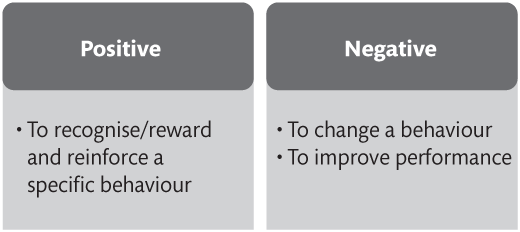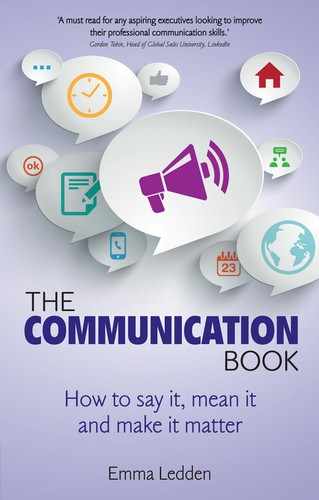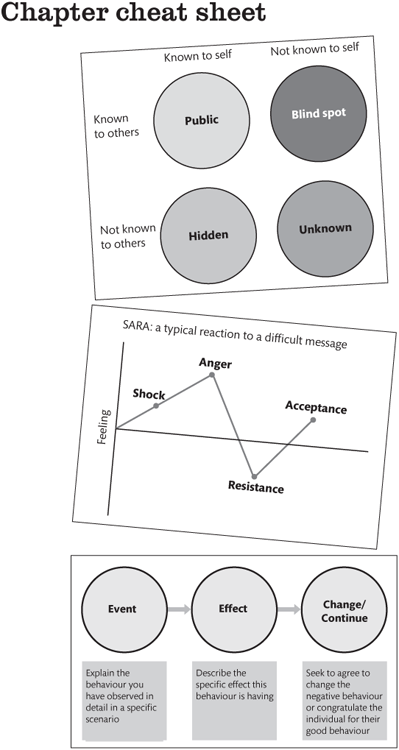STEP 1
Know the purpose
According to a survey from the L.E.A.D (Leadership, Employment and Direction) survey book by the LMA (Leadership Management Australia), ‘Today’s workplace – Present realities… Future realities’ (2013), the most important leadership attributes, in numerical order, are:
- A good communicator who can provide feedback
- Honest, trustworthy, ethical and fair
- Understanding and a good listener
- Compassionate, empathic and caring
- Knowledgeable, competent and able to multi-task.
The need for feedback
When you manage or supervise people, it is your responsibility to give them feedback on their behaviour – both positive and negative. A lot of people shy away from giving feedback, especially negative feedback, as they do not want to cause offence or upset.
When you are giving people feedback you are trying to improve their ability to do their job successfully. Sometimes you do this by pointing out what they are doing well (a positive behaviour) so they can continue to do this. Other times you need to point out what wasn’t done so well (a negative behaviour) so they can change it.
Types of feedback

I have never met a person who minds giving positive feedback.
However, negative (or developmental) feedback is a whole other ball game. Nobody likes giving that. It is such an awkward, uncomfortable conversation to have for everyone involved. You have no idea how the person will react to the negative feedback or if it will affect your relationship with them in the long term.
There are very genuine challenges when giving negative feedback. They include:
- giving feedback to someone in work whom you consider a friend as well as a colleague;
- not wanting to appear overly tough;
- not finding the right words to say;
- fearing a bad reaction;
- it’s uncomfortable for everyone involved.
Unfortunately, because of these real obstacles, the speaker’s goal is often just to get it over and done with as quickly as possible. Very often the person giving the feedback gives a vague, general, mixed-message-type feedback in the hope of not hurting the other person’s feelings. The conversation then turns into a very negative experience for both people.
Do we really need to give negative feedback?
If it is so uncomfortable for everyone involved, why do we have to give it at all? I mean, if it’s going to upset the other person maybe it’s best not to say anything?
I am afraid Jo and Harry would disagree.
In the 1950s American psychologists Joseph Luft and Harry Ingham developed a concept called the ‘Johari Window’, and this concept explains why we must give and receive feedback.

Source: Figure derived from Luft, J. and Ingham, H. (1955) ‘The Johari Window: A graphic model of interpersonal awareness’, proceedings of the Western Training Laboratory in Group Development. LA: UCLA Extension Office.
The idea behind the Johari Window is that we all have four selves, or sides, and each of these sides is either known or unknown to us or to others:
- Public: something you know about yourself and that others know about you too.
- Hidden: something you know about yourself but others do not know it about you.
- Unknown: something you don’t know about yourself and others don’t know either (a hidden talent).
- Blind spot: something you don’t know about yourself but others know it, see it and are impacted by it, possibly in a negative way.
We must give and receive feedback because of our blind spot.
The blind spot is what is unknown by the person about him/herself but which others know. The person doesn’t see it themselves but others see it and are impacted by it.
We must be told of any behaviour, positive or negative, we are not aware of that is impacting others because it will ultimately impact on us and our ability to be successful in our careers.
STEP 2
Understand your listener
Surprise!
Because most of the time the feedback we receive is in our blind spot, it tends to come as a surprise to us.
A good surprise – we are told of strengths we are not aware of that others admire.
A bad surprise – we are told a behaviour of ours is negatively impacting other people and causing them to view us in a negative light.
How feedback feels
Receiving feedback triggers us emotionally; therefore it must be emotionally processed. This emotional process is often referred to as SARA (Shock, Anger, Resistance, Acceptance).
- Shock: This is probably genuinely brand-new information to the listener. Keeping in mind that the feedback is based on something in someone’s blind spot, the first reaction they are going to have is shock – especially if what they hear is unexpected or contradicts their own view of themselves. When people are experiencing shock, they may say things like, ‘What? I don’t understand’.
- Anger: As the listener realises what the feedback means, shock can turn into anger. At that moment the person receiving the feedback feels very exposed and uncertain. During the anger stage, people may say things like, ‘Who said this anyway?’.
- Resistance: If feedback indicates the need for change, the listener may experience a period of resistance. Change can be difficult, or at least uncomfortable. Resistance is where they explain, blame and excuse. They brush off, deny and condemn. In truth, they do anything and everything to resist the change. When experiencing resistance, people may say, ‘That’s just the way I am, take it or leave it’, or ‘That’s just my personality, they are too sensitive’.
- Acceptance: Finally, as the listener processes the feedback, they come to a point of acceptance, which leaves them at a better, more aware place than where they started. When an individual is finally accepting their feedback, you may hear them say, ‘What can I do to improve?’ or ‘How can I best use this feedback?’.
People need to go through these four stages before they are able to use the feedback effectively to make improvements in their lives.

Straight to acceptance
Critical or unexpected feedback can leave someone in shock, feeling angry and possibly resistant to change for days, weeks, or longer.
The problem is, as the person giving the feedback, you want acceptance straight away. You don’t want someone processing their shock, anger or resistance with you. It’s uncomfortable to watch someone go through those emotions.
You must allow the person you are giving feedback to to have these feelings. They are allowed to be shocked, angry and even resistant. They are allowed to look for explanation and understanding. That is all they are doing.
The tightrope of empathy and authority you must walk as the speaker in this interaction is difficult to master. If your feedback has proper evidence behind it you should be able to move someone from shock to acceptance. If your feedback is vague, general and without evidence, then your listener may get stuck in one of the phases longer then you hoped.
The goal of good feedback is to try and move someone through this SARA process as easily as possible.
Let’s look at how you do this.
STEP 3
Prepare to speak
This is Philip. He is a newly appointed manager in a consulting firm. Up until now he has been working very hard, but since being promoted he seems to have changed his attitude and is distracted. He has not been paying attention at meetings and has been called a bad listener by many of his fellow team members.

He is now having a meeting with his manager to be given feedback.
This is how the conversation goes:
‘Hi Philip. I am here to give you some feedback I have received from the team. You have been very distracted lately, you are not listening at meetings and you need to pull your sock ups and pay more attention. OK? Thanks Philip.’
How do you think Philip is feeling?
Shocked, angry, resistant? Do you think Philip will accept this feedback straight away?
There is a good chance Philip won’t accept it because the problem with this feedback is it is too general and Philip could easily go into shock, anger or resistance, protesting his innocence or annoyance.
Philip may also feel his whole character is being attacked. Phillip feels he works very hard and it is unfair to get this feedback.
To ensure Philip changes his behaviour in future meetings, the feedback will need to be given in a step-by-step way that Philip can understand and digest. Also, the feedback will need to be far more specific and behaviour-based.
A feedback framework
There are many models of feedback. The one I would like to introduce you to is the EEC feedback model. This model is very simple and effective and applies to giving both positive and negative feedback.
EEC stands for:
- Event
- Effect
- Change/Continue

Let’s go back to Philip and see how the feedback conversation would go if the EEC feedback model was used. The manager begins:
‘Hi Philip. How are you? Is your current project going well and on target? How do you find working with the current team?’
From this the manager learns that Philip feels his current team leader is a bit domineering but he likes the team in general. He is very busy and wants to ensure the client is always happy. He has also told his manager he has a personal issue he is dealing with, but he doesn’t wish to talk about it today.
Armed with this information, the manager continues:
Event
‘Philip, you are a very valuable team member and we are very happy with how you have been working with the client. However, for the past four team meetings you have arrived between 15 and 30 minutes late, you have not prepared your update in advance (including not using the proper templates) and when your other team members are speaking you are on your blackberry the whole time. Are you aware of this?’
Effect
‘This behaviour is having an impact on your team and on the meetings. You are overrunning on your time slot to speak, meaning other people have to rush their own update or the meeting runs over. Also, being on your phone shows a level of disinterest and disrespect to the other speakers at the meeting. Can you see that from the team’s point of view?’
Change
‘Philip, as I said at the beginning, you are a valuable team member and we would like to support you in every way we can. Do you agree, from here on in, you will commit to arriving on time to every team meeting, preparing your update fully, and finally can you please commit to not bringing your phone into the meeting? Thanks Philip.’
The facts about feedback
Giving and receiving feedback is a vital skill in your communication tool-kit. It is not an easy conversation, and that is why you must be ready for it.
You do, of course, have to give the feedback no matter what, so don’t shy away from it at the last minute. Be clear, calm and confident in your information and empathetic yet assertive in your attitude. Remember the purpose of feedback is to help and support someone’s career development. Feedback is a good thing, no matter how uncomfortable it may feel.
FEEDBACK NEEDS TO:
- Be at the right time: give feedback as close to the event as possible.
- Ask them for their story first: ask them what happened and let them tell their story.
- Be behaviour-related: focus on visible actions and behaviours, not general character traits. Give specific examples during your feedback.
- Explain the impact: explain the impact that their actions and behaviour had on the team, the client or the work.
- Check for clear understanding: check they understand the feedback. Also ensure you understand their viewpoint.
- Discuss future solutions: ensure they know what actions and behaviours you expect in the future.
If you are the one on the receiving end of feedback, remember you are likely to experience SARA. Here are a few things to remember:
What’s in it for you?
Giving negative feedback is a difficult interaction for everyone. It is going to generate an emotional response in the other person, no matter how well it is done. Accept this.
If you have people who work for you it is your responsibility to make them aware of their blind spots – both the positive and negative behaviours they are not aware of.
My best advice is to make it about them as much as possible, rather than making it about you. Give good solid examples of the behaviour, give them a chance to speak first and, most importantly, allow them to feel their way through it.


